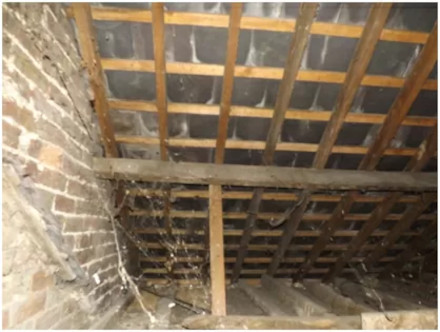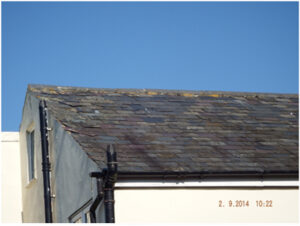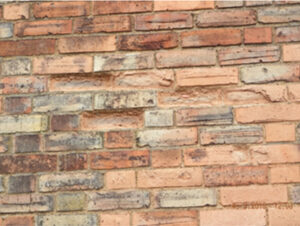Victorian Houses

While it is true that Victorian houses can be both interesting and quirky, they were not designed or built to anywhere near the standards we see in modern houses today and as such are prone to a number of building defects. In this article I will discuss a selection of typical defects that may be found in Victorian houses throughout Hertfordshire, Bedfordshire and Buckinghamshire.
Firstly and arguably one of the biggest differences between Victorian and modern houses is the approach to (or lack of) thermal insulation. Victorian houses would invariably be constructed using solid brickwork walls, usually 225mm (approximately 9in.).
There would be no insulation or damp proof membranes (DPM) in solid ground floors and no insulation in roof spaces. Air tightness was not a consideration and heating was usually limited to an open fire in the main room of the house. Basically these buildings were cold at certain times of the year and as such were susceptible to damp. I have surveyed many properties in Berkhamsted, Tring and surrounding villages that have had many attempts at preventing rising damp without the desired result. I have seen properties that have been rendered over twice to prevent rain penetration! And the internal walls have frozen over unfortunately the water was not penetrating it was condensation frozen, very pretty, problem solved by additional insulation.
Damp in a building can occur in a number of ways and will be influenced by construction details as well the internal and external environments. Within this article I do not want to discuss the science of condensation and rising damp. It is worth however appreciating that Victorian buildings are particularly vulnerable to damp unless of course remedial works/upgrading/refurbishment or whatever you want to call it are carried out. Interestingly, condensation is likely to have been less of a problem in Victorian times than it is today! Nowadays we emit huge volumes of water vapour into the air tight environments of our modern dwellings due to things such as showers, drying cloths on radiators, use of tumble dryers and portable gas heaters for example. None of these things existed in Victorian times and in addition to the fact that Victorian houses were not air tight and in fact they were quite draughty this conversely provided a good level of natural ventilation that would provide regular air changes which would reduce the risk of condensation.
Nail sickness
 Nail sickness is something that can be found on Victorian House on roofs. Nowadays, galvanised or non-ferrous fixings are used to secure roof tiles to timber roof laths however In Victorian times nails would have been ferrous (contain Iron), without any other coating or protection and as such would have been vulnerable to corrosion. The vast majority of original roofs would have been replaced, sometimes a number of times, so this is less of a problem nowadays. A good indicator of whether nail sickness is occurring will be loose or displaced roof tiles. Roof tiles can become displaced for other reasons so it is important to take into account the age and type of the building before deciding.
Nail sickness is something that can be found on Victorian House on roofs. Nowadays, galvanised or non-ferrous fixings are used to secure roof tiles to timber roof laths however In Victorian times nails would have been ferrous (contain Iron), without any other coating or protection and as such would have been vulnerable to corrosion. The vast majority of original roofs would have been replaced, sometimes a number of times, so this is less of a problem nowadays. A good indicator of whether nail sickness is occurring will be loose or displaced roof tiles. Roof tiles can become displaced for other reasons so it is important to take into account the age and type of the building before deciding.
Cast iron was widely used as a material for rainwater gutters and downpipes in Victorian times however it is less commonly found nowadays as many gutters and downpipes have been replaced with UPVC. Over time cast iron can be prone to corrosion if not maintain regularly which often results in other defects associated with rainwater leaking and saturating the building fabric which can lead to penetrating damp. With the rate at which steel and other metals has increased over the last few years, cast iron has become very expensive. Therefore, replica materials are sometimes used when restoring Victorian properties to provide original character features at an affordable cost.
Victorian Walls
 Houses constructed in the earlier Victorian period were constructed using red brick which were softer and less durable than later bricks and lime mortar. The use of cement in re-pointing mixes is generally considered as detrimental when replacing mortar that would have originally been lime based, resulting in accelerated decay and damp problems. A characteristic of mortars containing cement is their vulnerability to salt and possible sulphate attack. Also, the porosity of softer bricks is greater than the latter more durable bricks and as such have the ability to retain large quantities of water/moisture. If bricks are not allowed to dry out, then any trapped moisture within the bricks will freeze during sub-zero temperatures. When water freezes it increases in volume and will therefore expand within the pores of the brick often resulting in the face or the brick becoming detached and falling away (this is referred to as spalling).
Houses constructed in the earlier Victorian period were constructed using red brick which were softer and less durable than later bricks and lime mortar. The use of cement in re-pointing mixes is generally considered as detrimental when replacing mortar that would have originally been lime based, resulting in accelerated decay and damp problems. A characteristic of mortars containing cement is their vulnerability to salt and possible sulphate attack. Also, the porosity of softer bricks is greater than the latter more durable bricks and as such have the ability to retain large quantities of water/moisture. If bricks are not allowed to dry out, then any trapped moisture within the bricks will freeze during sub-zero temperatures. When water freezes it increases in volume and will therefore expand within the pores of the brick often resulting in the face or the brick becoming detached and falling away (this is referred to as spalling).
Victorian houses are prone to a whole range of defects that are also common with other types of buildings. The examples I have provided above are far from exhaustive however provide some information on some typical problems that may be found in Victorian Houses.

